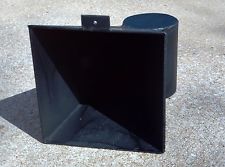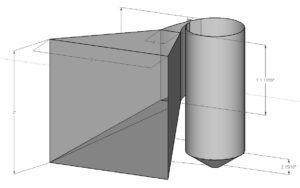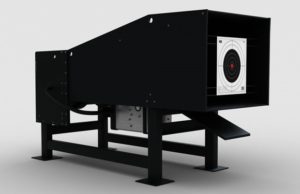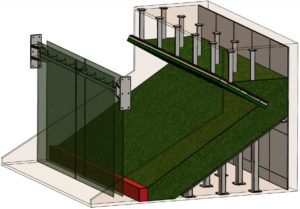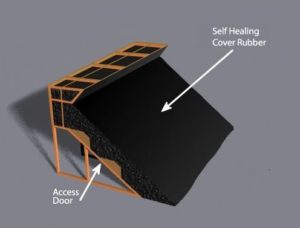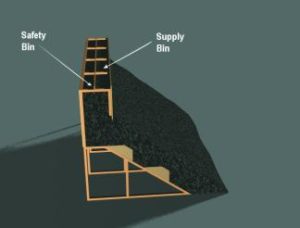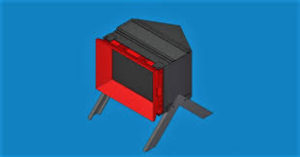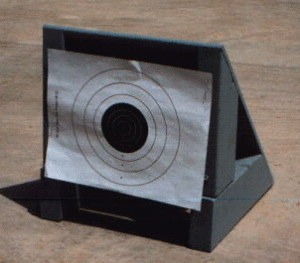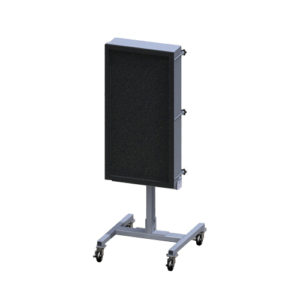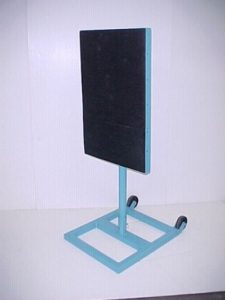Bullet Traps
The type of bullet trap design you choose is determined largely by:
- Air Quality
- Lead Management
- Noise Abatement
- Cost and ease of installation
- Space (footprint)
- Up front cost
- Cost of ownership and maintenance
- Type of shooting activity in your facility
- Safety
Rubber Bullet Trap utilizes a thick layer of granulated rubber material to safely capture bullets intact with virtually no lead dust or bullet fragmentation while reducing impact noise. This makes for a cleaner, safer range and is perfect for those who want to recover and recycle spent rounds.
- Saves on HEPA Filters
- Safe at Close Distance
- Minimal Maintenance
- Noise Reduction
- Low Up Front Cost
- High Volume
Ideal for tactical ranges, bullet trap allows shooters to advance downrange and engage targets at extremely close distances with no concern of bullet splatter. The granular rubber bullet trap is a high volume trap for indoor range as well as outdoor ranges. Compared to other bullet trap designs, the granular trap is easy to install, low cost and has a very low cost of ownership.
Steel Bullet Trap
Steel Bullet Trap is designed for heavy volume use and rated to stop all standard handgun rounds and rifle rounds up to 7.62 with a velocity of 3,000 fps. These type of bullet traps are self-supporting so it does not require additional structures for installation. Spent bullets collect in containers for safe handling and lead management, making reclamation easy. Steel Bullet Trap is perfectly suited for those who expect a heavy volume of rounds and do not anticipate advanced tactical training or advancement down range.
Deceleration Traps
Deceleration bullet traps direct bullets into a helical or circular chamber in which the bullet may circle until it loses velocity and drops to the bottom of the chamber for collection. For use with multiple firing positions, the helical chamber often resembles a horizontal pipe, into which bullets are directed by upper and lower steel plates. The upper plate slopes downward and the lower plate slopes upward to a horizontal slot in the side of the helical chamber. Alternatively, some narrow deceleration traps for single firing positions employ vertical plates to direct bullets into a helical deceleration chamber resembling a vertical pipe from which spent bullets drop out the lower end. Lightweight versions suitable for capturing airgun pellets are often used behind electronic scoring systems on ranges configured for ISSF 10 metre airgun events. The plate slopes are shallow (about 18° ) so bullets may be deflected relatively intact rather than disintegrated upon impact. Some deceleration traps use an oil and/or water coating to reduce friction and capture dust.
Friction Traps
Friction bullet traps slow and capture the bullet more gently than steel plates. This allows more effective capture of contaminants and reduces the production of dust as well as allowing for the capture of higher energy projectiles which would wear an impact trap too quickly and necessitate uneconomical levels of maintenance. The most common form of friction trap is a berm of granular material such as sand; earth or granulated rubber. In some circumstances a wall of railway ties, intact vehicle tires, or blocks of shock attenuating concrete (SACON) or other proprietary materials may be used. Such systems require less space than earthen berms whilst being quieter than steel impact or deceleration traps, which can be a significant consideration for urban outdoor range complexes. Individual bullet traps of this nature would typically be backed by a concrete wall to protect from negligent discharges or mechanical failures causing a bullet to miss the target entirely but which is not expected to be struck during the course of normal firing. Intact vehicle tyres are generally only suitable for higher energy projectiles which will easily penetrate their surface. Handgun bullets and shotgun pellets may ricochet back. Granulated rubber (often from shredded tires) is a convenient capture material from which bullets may be separated by gravity during agitation by subsequent bullet impact.
Impact Traps
Impact bullet traps typically use vertical or angled 500 Brinell hardness steel plate at least 0.375 inches (9.5 mm) thick for centrefire cartridges.Plate thickness of 4-6mm may be adequate for rimfire ammunition. Sloping plates deflect bullets downward into sand, water or some other capture material; but the plate angle is often steep enough to largely disintegrate the bullet upon initial impact, and bullets are expected to disintegrate upon impacting vertical plates. Shooter protection for firing positions within 25 metres (82 ft) of the impact plate may require an anti-splash curtain of Linatex or similar self-healing material hung in front of the plate to contain any fragments of “back splash” as well as dust. Rifle bullets may be partially melted by the energy of bullet impact. The spray of molten metal may solidify as dust, and lead bullets often leave a smear of lead upon impacting the steel plate. Smeared metal may be converted to additional dust by subsequent bullet impact.
The popularity of vertical plate installations for indoor ranges is largely down to their minimal footprint compared with sand, granular or helical bullet traps and can consume less than 1 foot (30 cm) of a room’s available length – comprising the thickness of the steel plate, the thickness of the anti-splash curtain and 10 to 11 inches of air gap between. However, sloping steel plates will tend to wear less quickly – particularly on precision target ranges where fixed targets result in fire being concentrated into small areas. In such cases, small sloping plates or sacrificial vertical wear plates may be placed behind the targets as the primary bullet trap, whilst a large vertical plate covers the remainder of the wall as the defense zone to catch errant shots. The small plates can be easily changed as frequently as necessary whilst the main back wall will need little maintenance from occasional scattered fire.
